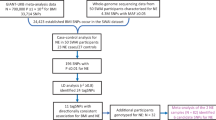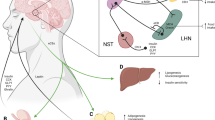Abstract
Background:
Gut hormones and their receptors are considered important in the control of feeding behavior. The gut hormone peptide-YY (PYY) has anorexic effects via the inhibitory neuropeptide Y2 receptor (Y2R) highly expressed in orexigenic NPY/AGRP neurons within the arcuate nucleus, a major integrator of appetite control in the hypothalamus.
Design:
Genetic case–control association study of single nucleotide polymorphisms (SNPs) in Y2R and PYY.
Subjects:
Swedish Caucasians comprising 148 lean, 129 overweight/obese and 226 morbidly obese men.
Measurements:
Genotypes of the common, silent and conserved SNP Y2R 585T>C and the common SNP PYY Arg72Thr, as well as various obesity-related clinical parameters.
Results:
Obese men had a lower allele and homozygosity frequency of the common allele 585T>C:T which was particularly evident comparing morbidly obese with lean men (P=0.002), and analyzing dependence between continuous body mass index (BMI) and genotype (P=0.002). In agreement, systolic blood pressure tended to be lower in those homozygous for allele T, which was not explained by the BMI – genotype dependence. We found no association to obesity for the PYY Arg72Thr polymorphism, which is located nearby the essential carboxy terminal.
Conclusion:
A common and conserved variant of the PYY and NPY receptor Y2R is less prevalent among obese compared to among lean Swedish men. This suggests that the common Y2R variant is protective against obesity. Our findings further implicate Y2R in food intake regulation.
This is a preview of subscription content, access via your institution
Access options
Subscribe to this journal
Receive 12 print issues and online access
$259.00 per year
only $21.58 per issue
Buy this article
- Purchase on Springer Link
- Instant access to full article PDF
Prices may be subject to local taxes which are calculated during checkout
Similar content being viewed by others
References
World Health Organization. Obesity: Preventing and Managing the Global Epidemic Report 894. World Health Organization, Geneva, Switzerland, 1998.
Barsh GS, Farooqi IS, O’Rahilly S . Genetics of body-weight regulation. Nature 2000; 404: 644–651.
Friedman JM . Modern science versus the stigma of obesity. Nat Med 2004; 10: 563–569.
Small CJ, Bloom SR . Gut hormones and the control of appetite. Trends Endocrinol Metab 2004; 15: 259–263.
Wynne K, Stanley S, Bloom S . The gut and regulation of body weight. J Clin Endocrinol Metab 2004; 89: 2576–2582.
Tatemoto K, Mutt V . Isolation of two novel candidate hormones using a chemical method for finding naturally occurring peptides. Nature 1980; 285: 417–418.
Batterham RL, Cowley MA, Small CJ, Herzog H, Cohen MA, Dakin CL et al. Gut hormone PYY (3–36) physiologically inhibits food intake. Nature 2002; 418: 650–654.
Batterham RL, Bloom SR . The gut hormone peptide YY regulates appetite. Ann NY Acad Sci 2003; 994: 162–168.
Adrian TE, Ferri GL, Bacarese-Hamilton AJ, Fuessl HS, Polak JM, Bloom SR . Human distribution and release of a putative new gut hormone, peptide YY. Gastroenterology 1985; 89: 1070–1077.
Grandt D, Schimiczek M, Beglinger C, Layer P, Goebell H, Eysselein VE et al. Two molecular forms of peptide YY (PYY) are abundant in human blood: characterization of a radioimmunoassay recognizing PYY1–36, and PYY3–36. Regul Peptides 1994; 51: 151–159.
Mentlein R, Dahms P, Grandt D, Kruger R . Proteolytic processing of neuropeptide Y and peptide YY by dipeptidyl peptidase IV. Regul Peptides 1993; 49: 133–144.
Grandt D, Schimiczek M, Rascher W, Feth F, Shively J, Lee TD et al. Neuropeptide Y 3–36 is an endogenous ligand selective for Y2 receptors. Regul Peptides 1996; 67: 33–37.
Keire DA, Mannon P, Kobayashi M, Walsh JH, Solomon TE, Reeve Jr JR . Primary structures of PYY, [Pro(34)]PYY, and PYY-(3–36) confer different conformations and receptor selectivity. Am J Physiol Gastrointest Liver Physiol 2000; 279: G126–G131.
Ingenhoven N, Eckard CP, Gehlert DR, Beck-Sickinger AG . Molecular characterization of the human neuropeptide Y Y2-receptor. Biochemistry 1999; 38: 6897–6902.
Broberger C, Landry M, Wong H, Walsh JN, Hokfelt T . Subtypes Y1 and Y2 of the neuropeptide Y receptor are respectively expressed in pro-opiomelanocortin- and neuropeptide-Y-containing neurons of the rat hypothalamic arcuate nucleus. Neuroendocrinology 1997; 66: 393–408.
Batterham RL, Cowley MA, Small CJ, Herzog H, Cohen MA, Dakin CL et al. Comment on: Physiology: does gut hormone PYY3–36 decrease food intake in rodents? Nature 2004; 430: 3–4.
Batterham RL, Cohen MA, Ellis SM, Le Roux CW, Withers DJ, Frost GS et al. Inhibition of food intake in obese subjects by peptide YY3–36. N Engl J Med 2003b; 349: 941–948.
Hung CC, Pirie F, Luan J, Lank E, Motala A, Yeo GSH et al. Studies of the peptide YY and neuropeptide Y2 receptor genes in relation to human obesity and obesity-related traits. Diabetes 2004; 53: 2461–2466.
Cerdá-Reverter JM, Larhammar D . Neuropeptide Y family of peptides: structure, anatomical expression, function, and molecular evolution. Biochem Cell Biol 2000; 78: 371–392.
Guo SW, Thompson EA . Performing the exact test of Hardy–Weinberg proportions for multiple alleles. Biometrics 1992; 48: 361–372.
Altschul SF, Madden TL, Schäffer AA, Zhang J, Zhang Z, Miller W et al. Gapped BLAST and PSI-BLAST: a new generation of protein database search programs. Nucl Acids Res 1997; 25: 3389–3402.
Apweiler R, Bairoch A, Wu CH, Barker WC, Boeckmann B, Ferro S et al. UniProt: the universal protein knowledgebase. Nucl Acids Res 2004; 32: D115–D119.
Rice P, Longden I, Bleasby A . EMBOSS: The European Molecular Biology Open Software Suite. Trends Genet 2000; 16: 276–277.
Clark JT, Kalra PS, Crowley WR, Kalra SP . Neuropeptide Y and human pancreatic polypeptide stimulate feeding behavior in rats. Endocrinology 1984; 115: 427–429.
Goumain M, Voisin T, Lorinet AM, Laburthe M . Identification and distribution of mRNA encoding the Y1, Y2, Y4, and Y5 receptors for peptides of the PP-fold family in the rat intestine and colon. Biochem Biophys Res Commun 1998; 247: 52–56.
Pheng LH, Fournier A, Dumont Y, Quirion R, Regoli D . The dog saphenous vein: a sensitive and selective preparation for the Y2 receptor of neuropeptide Y. Eur J Pharmacol 1997; 327: 163–167.
Rose PM, Fernandes P, Lynch JS, Frazier ST, Fisher SM, Kodukula K et al. Cloning and functional expression of a cDNA encoding a human type 2 neuropeptide Y receptor. J Biol Chem 1995; 270: 22661–22664.
Zukowska-Grojec Z, Karwatowska-Prokopczuk E, Rose W, Rone J, Movafagh S, Ji H et al. Neuropeptide Y: a novel angiogenic factor from the sympathetic nerves and endothelium. Circ Res 1998; 83: 187–195.
Michel MC, Beck-Sickinger A, Cox H, Doods HN, Herzog H, Larhammar D et al. XVI International Union of pharmacology recommendations for the nomenclature of neuropeptide Y, peptide YY, and pancreatic polypeptide receptors. Pharmacol Rev 1998; 50: 143–150.
Csiffary A, Gorcs TJ, Palkovits M . Neuropeptide Y innervation of ACTH-immunoreactive neurons in the arcuate nucleus of rats: a correlated light and electron microscopic double immunolabeling study. Brain Res 1990; 506: 215–222.
Cowley MA, Smart JL, Rubinstein M, Cerdan MG, Diano S, Horvath TL et al. Leptin activates anorexigenic POMC neurons through a neural network in the arcuate nucleus. Nature 2001; 411: 480–484.
Roseberry AG, Liu H, Jackson AC, Cai X, Friedman JM . Neuropeptide Y-mediated inhibition of proopiomelanocortin neurons in the arcuate nucleus shows enhanced desensitization in ob/ob mice. Neuron 2004; 41: 711–722.
Naveilhan P, Hassani H, Canals JM, Ekstrand AJ, Larefalk A, Chhajlani V et al. Normal feeding behavior, body weight and leptin response require the neuropeptide Y Y2 receptor. Nat Med 1999; 5: 1188–1193.
Sainsbury A, Schwarzer C, Couzens M, Fetissov S, Furtinger S, Jenkins A et al. Important role of hypothalamic Y2 receptors in body weight regulation revealed in conditional knockout mice. Proc Natl Acad Sci USA 2002; 99: 8938–8943.
Herzog H . Neuropeptide Y and energy homeostasis: insights from Y receptor knockout models. Eur J Pharmacol 2003; 480: 21–29.
Dumont Y, Martel JC, Fournier A, St-Pierre S, Quirion R . Neuropeptide Y and neuropeptide Y receptor subtypes in brain and peripheral tissues. Prog Neurobiol 1992; 38: 125–167.
Narváez JA, Aguirre JA, Fuxe K . Subpicomolar amounts of NPY(13–36) injected into the nucleus tractus solitarius of the rat counteract the cardiovascular responses to L-glutamate. Neurosci Lett 1993; 151: 182–186.
Schwertfeger E, Klein T, Vonend O, Oberhauser V, Stegbauer J, Rump LC . Neuropeptide Y inhibits acetylcholine release in human heart atrium by activation of Y2-receptors. Naunyn Schmiedebergs Arch Pharmacol 2004; 369: 455–461.
Cartegni L, Wang J, Zhu Z, Zhang MQ, Krainer AR . ESEfinder: a web resource to identify exonic splicing enhancers. Nucl Acids Res 2003; 31: 3568–3571.
Snyder EE, Walts B, Pérusse L, Chagnon YC, Weisnagel SJ, Rankinen T et al. The human obesity gene map: the 2003 update. Obes Res 2004; 12: 369–439.
Acknowledgements
The laboratory assistance of Selim Sengul, Britt-Marie Leijonhufvud, Katarina Hertel, Eva Sjölin, Kerstin Wåhlén and Elisabeth Dungner, and the manuscript review by Martin Schalling are greatly acknowledged. This study was supported by grants from Swedish Medical Research Council, Swedish Diabetes Association and Novo Nordic Foundation.
Author information
Authors and Affiliations
Corresponding author
Rights and permissions
About this article
Cite this article
Lavebratt, C., Alpman, A., Persson, B. et al. Common neuropeptide Y2 receptor gene variant is protective against obesity among Swedish men. Int J Obes 30, 453–459 (2006). https://doi.org/10.1038/sj.ijo.0803188
Received:
Revised:
Accepted:
Published:
Issue Date:
DOI: https://doi.org/10.1038/sj.ijo.0803188
Keywords
This article is cited by
-
Suggestion of new possibilities in approaching individual variability in appetite through constitutional typology: a pilot study
BMC Complementary and Alternative Medicine (2012)
-
Ghrelin, the proglucagon-derived peptides and peptide YY in nutrient homeostasis
Nature Reviews Gastroenterology & Hepatology (2012)
-
Polymorphisms in the NPY2R Gene Show Significant Associations With BMI That Are Additive to FTO, MC4R, and NPFFR2 Gene Effects
Obesity (2011)
-
Metabolic surgery—principles and current concepts
Langenbeck's Archives of Surgery (2011)
-
Association between BBS6/MKKS gene polymorphisms, obesity and metabolic syndrome in the Greek population
International Journal of Obesity (2008)



